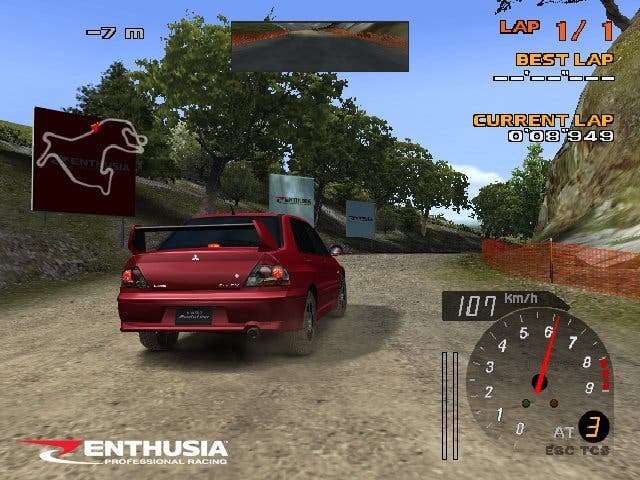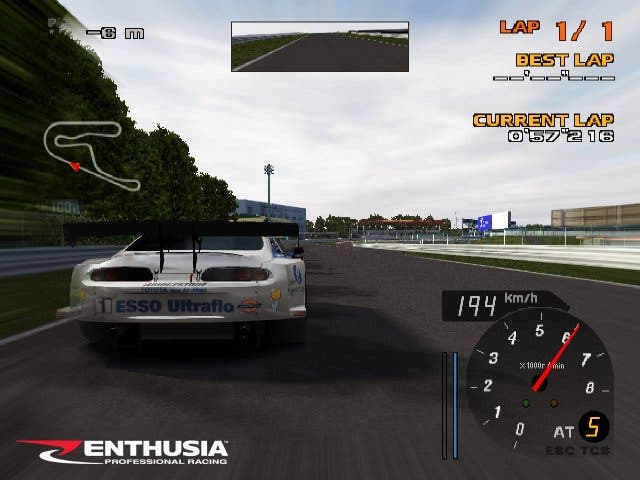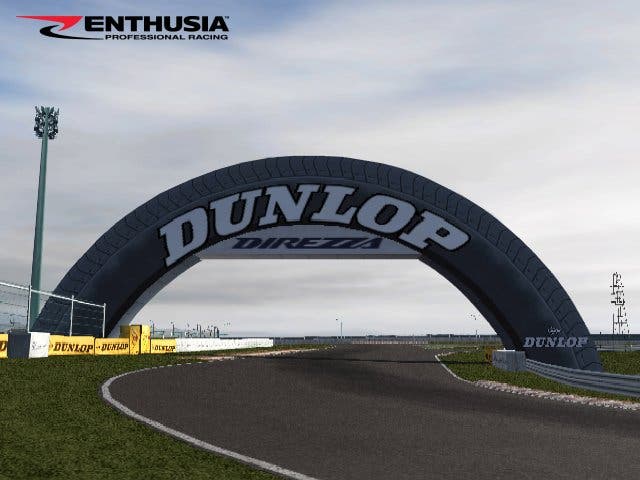Enthusia Professional Racing
Konami takes on Gran Turismo.

"Not another bloody driving game" you're probably thinking. Not the most "adrenaline fuelled" and "intense" way to kick off our build up coverage to Konami's arrival onto the starting grid, but let's be honest right from the start here: it's going to take a lot to get consumers to down tools with heavyweights like Gran Turismo around, not to mention the already well-established supporting cast of TOCA, Project Gotham, the forthcoming Forza and vast numbers of arcade racers, rally games, F1 titles and gawd knows what else busily selling millions across the globe. Enthusia had better be bloody good from the very beginning or what chance does it have in this cutthroat and saturated market? Colour us unenthused.
Being dragged kicking and screaming on a three day press jolly to Dubai, driving 4x4s in the desert, camel riding, quaffing champagne at sunset (still in the middle of the desert), being treated to a belly dancing feast and generally being given the royal treatment at a seven star hotel that frankly shames even Vegas for its salubriousness probably made us more suspicious than anything. Konami's PRs will already be rolling their collective eyes suspecting that Eurogamer's first trip away at their expense would be the last, but we really couldn't fathom the point of yet another bloody racing game. Until we, you know, actually bothered to sit down and play the thing.
In terms of the preview event - two days of travel notwithstanding - we barely got to even see the game. Sure, there was a few demo pods laid on towards the latter part of the 'event', but we were all too sandblasted to hell to give it more than the polite cursory few laps as part of a brief time trial competition. Just as well Konami supplied us with a near-as-dammit finished build, then.

Since then, we've ummed and ahhed in hopeless procrastination to get around to playing it, but we're glad we finally did. It's a fine racing game, nowhere near as po-faced and serious as we initially suspected. Having spent a good six hours battling through the various modes it sits nicely between the obsessive depth of GT and the fun handling of Ridge Racer - which will come as less of a surprise once you learn that the man spearheading the project, Manabu Akita, once plied his trade at Namco, cutting his teeth on Ridge Racer no less.
On the surface there's not a huge amount to help Enthusia stand out. Race through tiers of difficulty, win races, build up experience and ranking points, unlock more powerful cars and new tiers and gradually work your way up the leaderboard - right the way from 1000 up to the top slot.
But the main dish of Enthusia Life has a somewhat novel twist on Gotham's Kudos system and GT's A/B-Spec mechanic of offering odds on your chances of winning depending on the capabilities of your vehicle. Choose something low specced and you'll win points based on your placing. Get around the track without crashing, going off course or hitting the barriers and you'll be rewarded further. Drive like a lunatic and you'll lose all you 'Enthusia' points and be forced to choose another car for the next race.

Enthusia calculates your overall ranking based on the last 12 weeks of racing, and so while winning is obviously a good thing, winning and ending up without any Enthusia points will mean skipping a week. It's an interesting dynamic where winning really isn't everything, and forces you to adopt a slightly different mindset of simply barging your way to the front and caning it all the way around for three laps. A race analyser displays an overhead diagram of your sins lap by lap at the end of a race, showing exactly where you erred, which is a thoughtful addition, if perhaps rather superfluous.
Occasionally a car 'raffle' will appear at the end of a race, allowing you to quickly build up a collection of new cars to choose from. After four hours with Enthusia Life we'd already jumped up to the third tier, and had a collection of 16 new cars to add to the rather hopeless 12-strong fleet you start off with, and it felt like a genuinely fun, approachable racing game with an excellent handling model that while not maybe up everyone's street is a hell of a lot more forgiving and subsequently more fun from the beginning, while still managing to maintain a sense of realism.
Don't be fooled by the Ridge Racer drift comparisons, though. In the context of Enthusia the use of the handbrake is just so - something which the challenge-based Driving Revolution mode teaches you very quickly. This suite of 72 individual racing challenges over 18 courses works rather like GTA San Andreas' driving school mini-games, whereby you have to score enough points to progress to the next level. As you'd expect these challenges start off nice and simple with basic speed-based challenges, then begin to up the ante by tasking you with driving through markers at set speeds, requiring careful use of throttle and brake to pull off as things get progressively more difficult. As a visual indicator, these markers change colour to represent how near the mark you are, with green for perfect, going through great to good to bad via various shades through to brown. It's instinctive, intuitive, and best of all addictive as hell.

Admittedly Enthusia has a few chinks in its armour; the visuals are simply not in the same league as GT. Comparing the two games' respective takes on the Tsukuba Circuit provided us with all the evidence we needed to verify that fact. It's by no means a bad looking game by any stretch of the imagination, but with a lack of widescreen mode and less texture detail, it's going to be a hard sell getting people to be wowed by it just running on, say, a demo pod. It's a game you simply have to play to decide whether you like it or not.
Although Konami made a big deal out of Enthusia's central innovation - the Visual Gravity System (VGS) - we remain unconvinced it makes any real world difference in game. Basically, the idea was to give players handy visual feedback in the form of a circular diagram just at the lower centre of the screen under the car. But while, in theory, it shows where the car is feeling the most pressure and strength of the G-Force, all that happens is you occasionally acknowledge a yellow ball wobbling between the four wheels of the overhead diagram, but how this actually aids your driving is hard to say. The visual feedback from the car, the engine and tyre sounds give a far better sense of how well you're driving, but there you go. Gimmicks and all that.
Aside from that we came away from our time with Enthusia itching to get further into it - and that's as good an indicator as any as regards whether it's worth paying attention to when it finally ships sometime later this summer. By then we'll have really cracked it and played it for all it's worth, so check back again for more on Konami's big hope for cracking the racing genre.

